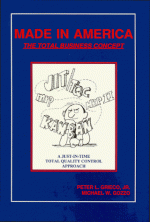What is Just-In-Time/Total Quality Control (JIT/TQC)? It is an often talked about, but infrequently applied approach to manufacturing excellence which seeks to minimize waste, obsolescence and complexity. It is not a vastly complicated program nor a computer software system. Indeed, it is not new in the sense of being a revolutionary vision of the workings of a manufacturing company.
JIT/TQC is in part a resurrection, a redefinition of manufacturing objectives and an unrelenting commitment to them. It is not, repeat not, only an inventory reduction program, but includes this in a holistic approach to company operations. JIT/TQC is a quest for the causes of wasted time, money and labor and an attempt to destroy what we refer to as the "Ubiquitous RE-"-rework, repair, reject, refuse and so on.
We treat JlT/TQC holistically in this book because there is not a department or area in which its effects are not felt. Often, we refer to its far-reaching implications as a spider's web. Touch one silken strand and the entire web vibrates and alerts the spider to a possible meal. Likewise, JIT/TQC alerts plant managers to the presence of problems that we Americans have too often covered with large stocks of inventory and wasteful operations in the belief that foreign competition will be minimal and that our economy will expand at a comfortable rate.
How, then, can we simply define JIT/TQC? The right item in the right place at the right time in the right quantity with no defects, every time and everywhere in the company. This could mean the right information as well as the right amount of raw material. Most companies adopting JIT/TQC are more surprised by the indirect effects than the obvious ones. We can't emphasize enough that a total commitment to quality and efficiency at every step by all workers, whether on the shop floor or in the managerial offices, will produce effects that nobody had originally surmised.
Thus, JIT/TQC is a mind-set, or a total business philosophy, which can help American manufacturers who find themselves in the throes of the greatest overhaul since the Industrial Revolution. This overhaul has been forced upon us by our own neglect while, at the same time, nations capable of producing higher quality at lower cost swallowed up our market share. Many American companies, scrambling to find ways to increase productivity and cut costs, have moved their operations off-shore to obtain the low unit cost they have been unable to achieve here.
We don t believe that is the answer. The principal goal of this book is to show you how we can get our manufacturing operations back on the road to productivity. That will take an honest appraisal of why we have problems. Indeed, it will mean finding the problems, rather than reacting to the symptoms. Additionally, we wish to make it clear that we are in a crisis of quality. And that will demand another honest self-evaluation of why we have grown accustomed to extensive rework, excess inventory sitting on plant floors, poor shipping performance from suppliers and past due orders.
Everyone in manufacturing, whatever the industry, whatever the operation, can benefit from a discussion of JIT/TQC which unites theory, practical advice and actual case studies. We view our efforts as a handbook for those who believe we can revive American manufacturing with something other than empty talk or technological fixes. Those who read this book will run the gamut of manufacturing operations- corporate management, design engineering, production planning, human resources, information systems management, marketing, purchasing, accounting, shop floor control, warehouse management. For a holistic business philosophy, it could be no other way.
We never present JIT/TQC as a prepackaged action plan. You will use what you need, but you will be able to choose only after you have digested the whole. Nevertheless, there are four areas which are essential: QUALITY, QUANTITIES, SUPPLIERS and LOGISTICS.
QUALITY is the number one issue. Without defect-free parts coming into your factory, there is no chance for you to achieve the levels of efficiency and productivity that JIT/TQC promises.
Smaller QUANTITIES applies to a number of company practices -reduced lot sizes, lower inventory levels, reduced work-in-process levels. JIT/TQC is not only the just-in-time delivery of parts from an outside supplier. Such delivery schedules, where less parts are dropped off on a more frequent basis, requires the coordination of a number of inside activities in your company.
JIT/TQC will not work without dramatically better relations with your SUPPLIERS. In order for them to meet your frequent delivery schedule and your demand for zero-defect parts, you must be willing to work with them. This can, and should, mean making a long-term commitment, sharing engineering changes, supplying them with long-term delivery schedules and exchanging product expertise. In short, suppliers become partners.
Lastly, there is LOGISTICS which is not only getting the ordered material to your loading dock, but getting it from your loading dock to the shop floor. JIT/TQC will not work if you can't get material to your production lines fast enough to keep them from shutting down. Remember, that in the JIT/TQC environment, there is no excess inventory sitting around that you can use while you wait. Ideally, you should work toward shipping directly to the line, rather than to a receiving area. This will work when customers demands are quickly relayed to the plant in order to pass them on just as quickly to suppliers.
One last word. We often speak of ideal situations as though nothing less than their attainment is satisfactory. We won't back down from that demand which we think all American manufacturing companies should place upon themselves. If you have a 95 percent quality level, strive for 98 percent. When you reach that level, go for 99 percent. Once there, go for 99.8 percent. There is no stopping in JIT/TQC, no resting on your laurels. It is a commitment to the elimination of all waste in your company and the employment of the Total Business Concept.

























